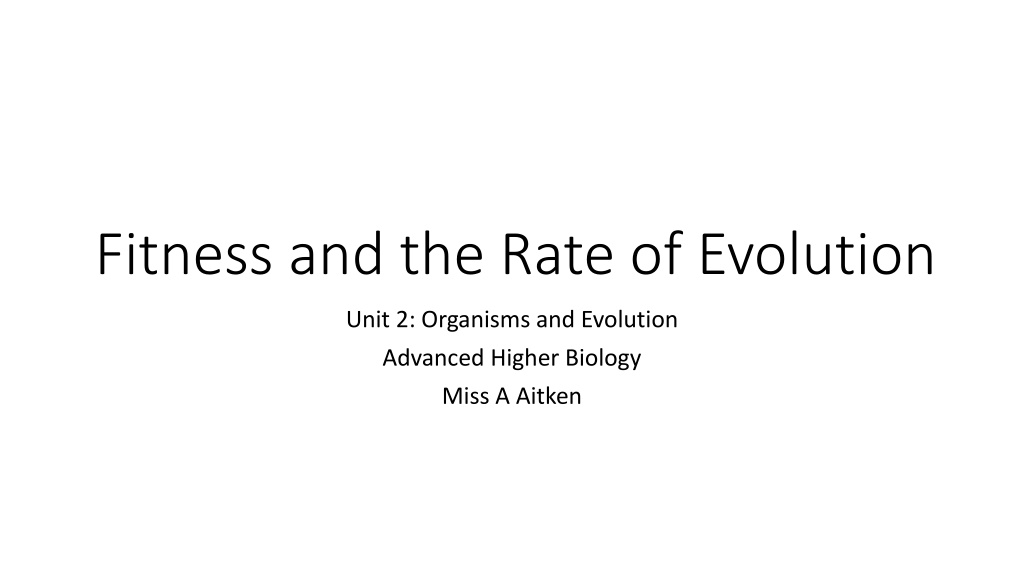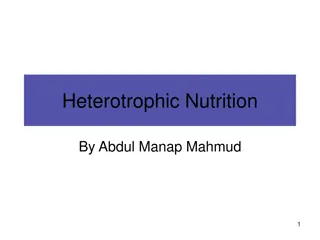Understanding Fitness and Evolution Rates in Organisms
Fitness in organisms is crucial for their survival in a given environment. Absolute fitness measures genotype frequencies between generations, while relative fitness compares genotypes to the most successful one. Factors like selection pressure can increase the rate of evolution by promoting beneficial traits. Explore how these concepts shape the evolution of organisms.
Download Presentation

Please find below an Image/Link to download the presentation.
The content on the website is provided AS IS for your information and personal use only. It may not be sold, licensed, or shared on other websites without obtaining consent from the author. Download presentation by click this link. If you encounter any issues during the download, it is possible that the publisher has removed the file from their server.
E N D
Presentation Transcript
Fitness and the Rate of Evolution Unit 2: Organisms and Evolution Advanced Higher Biology Miss A Aitken
Fitness Fitness usually refers to the organism s suitability for the environment they are currently in. Two types of fitness measurement: Absolute Fitness Relative Fitness
Absolute Fitness The ratio of frequencies of a particular genotype in one generation compared to the previous generation.
Absolute Fitness In the left hand diagram, there are 10 individuals, and only one of them has the genotype dd . 1/10 = 0.1 This genotype has a frequency of 0.1
Absolute Fitness In the right hand diagram, there are 8 individuals, and 2 of them have the genotype dd . 2/8 = 0.25 This genotype has a frequency of 0.25
Absolute Fitness Comparing 0.25 (offspring) to 0.1 (previous generation) 0.25/0.1 = 2.5 The absolute fitness of genotype dd = 2.5
Absolute Fitness Now calculate the absolute fitness for genotypes DD and Dd:
Relative Fitness The absolute fitness of one genotype compared to the absolute fitness of the most successful genotype.
Relative Fitness In the right hand diagram, the absolute fitness of dd is 2.5. It is the most successful genotype So it s relative fitness is 2.5/2.5 = 1 Work out the relative fitness of DD and Dd.
Factors that Increase the Rate of Evolution Factors that Increase the Rate of Evolution 1. Higher Selection Pressure: A selection pressure is a factor such as disease, predators, threat to the environment. Higher selection pressure increases the heritability of beneficial traits and weeds out weak traits. A higher selection pressure means the rate of evolution is more rapid.
Factors that Increase the Rate of Evolution Factors that Increase the Rate of Evolution 2. Shorter Generation Times: If generation times are short, then more generations of a species can be produced in a certain period of time. More generations = more evolution. A female mouse can have a litter of babies when she is 6-8 weeks old. Pregnancy lasts 3 weeks. She can have 5-10 litters per year. A female elephant can only become pregnant once she is around 18 years old. She then carries one baby elephant for 22 months before giving birth. She is only pregnant once every 3-5 at most.
Factors that Increase the Rate of Evolution Factors that Increase the Rate of Evolution 3. Warmer Environments: Many organisms do not regulate their body temperature meaning that when they are in a warm environment, they are warmer, and their enzymes work faster. More DNA replication = greater chance of mutation Even mammals which regulate their temperature can be affected. Mammals in cold climates who hibernate (e.g. bear) have a slower metabolic rate, slower rate of DNA replication and less likelihood of mutations happening.
Factors that Increase the Rate of Evolution Factors that Increase the Rate of Evolution 4. Sexual Reproduction: Combining genetic material with another individual leads to increased variation. Greater variation leads to more selection and faster evolution. Sexual reproduction also means that beneficial DNA sequences are shared between different lineages, producing offspring with new combinations of beneficial alleles.
Factors that Increase the Rate of Evolution Factors that Increase the Rate of Evolution 5. Horizontal Gene Transfer: Some organisms, like bacteria, can pass genetic material to other members of the same species. This is called horizontal gene transfer because the DNA is being passed across, and not DOWN to offspring. This means bacteria evolve rapidly and can pass on beneficial sequences, leading to things like antibiotic resistance.

























